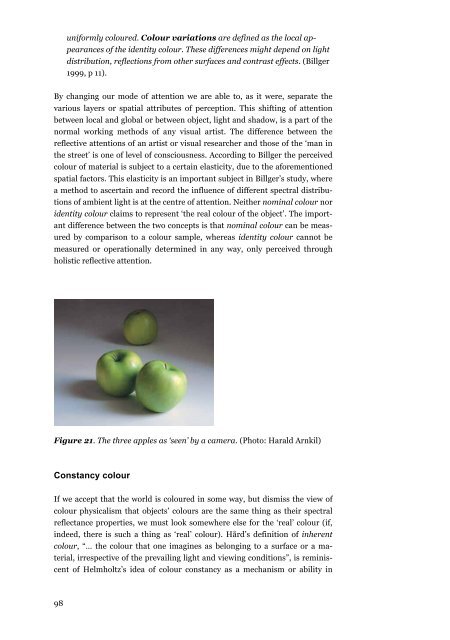Lightness and Brightness and Other Confusions
Lightness and Brightness and Other Confusions
Lightness and Brightness and Other Confusions
You also want an ePaper? Increase the reach of your titles
YUMPU automatically turns print PDFs into web optimized ePapers that Google loves.
uniformly coloured. Colour variations are defined as the local appearances<br />
of the identity colour. These differences might depend on light<br />
distribution, reflections from other surfaces <strong>and</strong> contrast effects. (Billger<br />
1999, p 11).<br />
By changing our mode of attention we are able to, as it were, separate the<br />
various layers or spatial attributes of perception. This shifting of attention<br />
between local <strong>and</strong> global or between object, light <strong>and</strong> shadow, is a part of the<br />
normal working methods of any visual artist. The difference between the<br />
reflective attentions of an artist or visual researcher <strong>and</strong> those of the ‘man in<br />
the street’ is one of level of consciousness. According to Billger the perceived<br />
colour of material is subject to a certain elasticity, due to the aforementioned<br />
spatial factors. This elasticity is an important subject in Billger’s study, where<br />
a method to ascertain <strong>and</strong> record the influence of different spectral distributions<br />
of ambient light is at the centre of attention. Neither nominal colour nor<br />
identity colour claims to represent ‘the real colour of the object’. The important<br />
difference between the two concepts is that nominal colour can be measured<br />
by comparison to a colour sample, whereas identity colour cannot be<br />
measured or operationally determined in any way, only perceived through<br />
holistic reflective attention.<br />
Figure 21. The three apples as ‘seen’ by a camera. (Photo: Harald Arnkil)<br />
Constancy colour<br />
If we accept that the world is coloured in some way, but dismiss the view of<br />
colour physicalism that objects’ colours are the same thing as their spectral<br />
reflectance properties, we must look somewhere else for the ‘real’ colour (if,<br />
indeed, there is such a thing as ‘real’ colour). Hård’s definition of inherent<br />
colour, “… the colour that one imagines as belonging to a surface or a material,<br />
irrespective of the prevailing light <strong>and</strong> viewing conditions”, is reminiscent<br />
of Helmholtz’s idea of colour constancy as a mechanism or ability in<br />
98
















